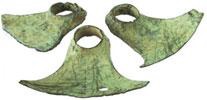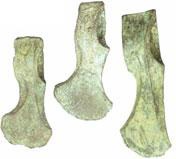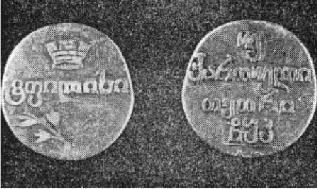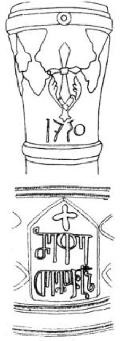Metallurgy - a science about mining of metals and alloys from ores and manufacturing from them subjects of different function - is one of the most ancient and major achievements of a civilization. Origination of metallurgy at initial stage of the mankind development gave rise to the notable socialeconomic progress, facilitating differentiation of the society (Jean-Jacques Rousseau).
Discovered at the close of the 20th century in Georgia skeleton “homo erectus” (rectified man), its age reaching 1,7 million years of life, defined geographical area for human dwelling place and with amazing accuracy confirmed the assumption of Wilhelm Humboldt that prehistorical process of the mankind development took place in the Meditteranean basin and the Caucasus. Scientists found Georgia territory belonging to that regional group of the planet, wherein the human being was formed and wherefrom people were settled in the Eurasia territory.
Development of copper-bronze metallurgy started in the Georgian territory in the IV millenium B.C. There appeared farming tools and the world-known colchis axe, livestock was used as a pulling force and the land was profoundly cultivated.
During latebronze-earlyiron age of civilization (the 2nd half of II millenium BC) Colchian civilization was developed in the West Georgia. Greatness and brilliance of the Colchis kingdom were accurately portrayed in the ancient epos about Argonauts, the heroes of which accompanied Jason to Colchis in his quest to find the Golden Fleece in the land of Aeetes and Medea.
According to Antic, Hellenistic and Byzantine sources, the Golden Fleece is an allegoric form of a poetic depiction of this story. In reality it is taboo secret information inscribed on the leather about goldmining by Colchis method (Strabo - I c. BC, Apiane - II c.). The gold washed from the rivers was collected by the natives on the fur leather. Noteworthy, that the secret of depositing gold on the sheep leather is still applied in Svanetia for mining gold. Anyway, this Colchis method can be freely considered a germ of hydrometallurgy and enrichment flotation method.
In Colchis territory many mining-metallurgy sites which in the Antic age supplied metal produce to not only Colchis kingdom but also to the neighboring states. Among abundant archaeological materials, predominating are the items of local production - Colchis axe, heads of spears and arrows, wooden cutters, farming tools, gold and bronze different decorative manufactures, jewellery, numismatic material, etc. A silver coin known as “Colchis white”, Colchis axes and other material articles have been obtained in different centers of Greek world - the Crimea, Turkey (near Trabzon), the Central Asia (Fergana valley), serving as evidence of the Colchis` close contacts with the outer world. This fact can convince even the most skeptical person that metallurgy in the territory of Georgia in ancient times was developed at a high level.
Noteworthy is the fact of almost recent discovery of Sakdrisi gold-mining deposit in Bolnisi, near socalled Khachaghiani territory, its age presumably III millenium BC is exceeding that of the Egyptian gold.
Thereby, metallurgy as the tradition for obtaining metal and manufacturing from it different items was a natural and essential activity for the Georgians.
|
|
|
|
|
Bronze hoes of XIII-XII cc BC |
Colchic axes of XVI-XV cc BC |
Bronze dagger of XV-XIV cc BC |
Some specimens of detected in Georgia archaeological material, which were investigated in the Institute of metallurgy
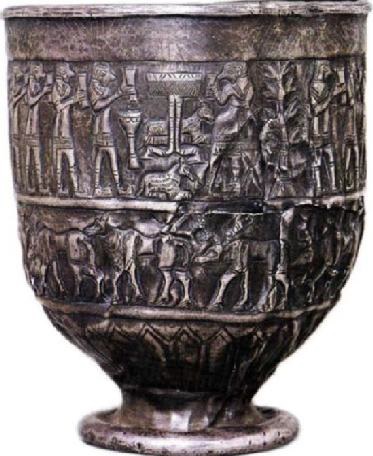
Silver bowl with ritual sketches. Trialeti. XV c. BC. Molding technology for receiving such
hollow-body manufactures was established according to Ferdinand Tavadze investigations
The traditions of development of metallurgy were continued in medieval Georgia. David the Builder`s military successes were largely due to the high-quality steel armament. A Georgian horseman`s complete set of an equipment weighing approximately 10-12 kg. is kept in the Georgian National museum. According to these data only on armament of 40 thousand Kivchag warriors 400-480 tons of qualitative steel-iron were required. In that era production of steel in such quantity is surprising.

Gorget armor
Author Gocha Lagidze, 1995. https://www.gotscha.nl/ge-abjari.html
The tendencies of metallurgy development in Georgia are continuous. This can be ascertained by the fact of successful activities of the numerous metallurgical and metal-processing works functioning in Kartalian and Kakhetian territories in the XVIII century.
|
|
|
Georgian coins made in the Mint in 1820 and symbols of Georgian cannons
Hereby it is obvios that a Georgian man all along his long-term history spent most of his time at the furnace and smithy manufacturing horseshoes, sickles, hoes and other household goods, as well as continually forging arms for defense purposes.
